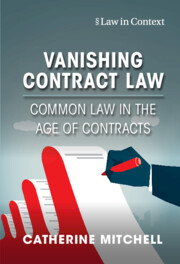Book contents
- Vanishing Contract Law
- Law in Context
- International Journal of Law in Context: A Global Forum for Interdisciplinary Legal Studies
- Vanishing Contract Law
- Copyright page
- Contents
- Preface
- Acknowledgements
- Table of Cases
- Table of Statutes
- 1 Vanishing Contract Law
- 2 Contract Common Law Trends
- 3 Contractualisation and the Common Law Retreat
- 4 Private Ordering, Regulation and Contract Law
- 5 Contracts through the Gaps
- 6 Future Challenges for Contract Law
- 7 The Possibility of Common Law Revival
- 8 Conclusion
- Select Bibliography
- Index
2 - Contract Common Law Trends
Published online by Cambridge University Press: 25 August 2022
- Vanishing Contract Law
- Law in Context
- International Journal of Law in Context: A Global Forum for Interdisciplinary Legal Studies
- Vanishing Contract Law
- Copyright page
- Contents
- Preface
- Acknowledgements
- Table of Cases
- Table of Statutes
- 1 Vanishing Contract Law
- 2 Contract Common Law Trends
- 3 Contractualisation and the Common Law Retreat
- 4 Private Ordering, Regulation and Contract Law
- 5 Contracts through the Gaps
- 6 Future Challenges for Contract Law
- 7 The Possibility of Common Law Revival
- 8 Conclusion
- Select Bibliography
- Index
Summary
This chapter briefly examines contract law trends over the past 200 years or so. The chapter explores the development of the common law of contract, identifying the broad shift from the classical law of the 1800s to the neo-classical law characteristic of the second half of the twentieth century. By the second half of the twentieth century, thanks to the rise of the consumer and empirical evidence demonstrating the minor role played by contracts and contract law in business practice, the classical law model appeared to be under considerable pressure from realist and contextualist rivals that stressed the life of a contract outside its formal express terms. The shift to a more standards-based, neo-classical contract law in response to these tensions was not easily confined to consumer contracts, and there was plenty of scope for importing the broad values of ‘consumer-welfarism’ into commercial contracts. The move to a contextual method of interpretation and the willingness to relax doctrines such as consideration in response to business realities suggested further classical law disintegration. The chapter notes that this process now seems to have gone into reverse.
- Type
- Chapter
- Information
- Vanishing Contract LawCommon Law in the Age of Contracts, pp. 26 - 52Publisher: Cambridge University PressPrint publication year: 2022

